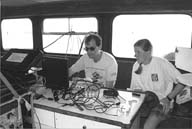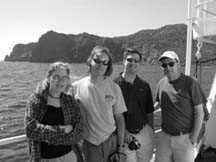|
Rethinking
Deep Water Archaeology
by Andrea Cohen, MIT Sea Grant
When David Mindell describes diving 3,000 feet in a nuclear submarine
and eyeballing a Roman shipwreck unseen by humans since its sinking
2,000 years back, it's hard not to think of him as a time traveler.
Mindell was part of the team that surveyed two Phoenician shipwrecks
from the 8th-century B.C. off of Ashkelon, Israel; he has searched
for ancient wrecks in the Black Sea; he surveyed the USS Yorktown,
sunk in the Battle of Midway; and he's surveyed the ironclad Civil
War ship USS Monitor.
 |
| David
Mindell and Sarah Webster navigating on the Black Sea. Photo
credit: DeepArch |
As both a historian
of technology and an engineer, MIT's Mindell develops methods for
surveying deep water wrecks, and more broadly, developing new ways
of thinking about archaeology in deep water. The Dibner Associate
Professor in the History of Engineering and Manufacturing in the
Program on Science, Technology, and Society (STS) and director of
MIT's DeepArch Research Group is aided by MIT graduate students
Brendan Foley, a Ph.D. candidate in the STS program, Brian Bingham,
a Ph.D. candidate in the Department of Mechanical Engineering, and
Katie Croff, who's pursuing a dual Ph.D. in Ocean Engineering and
Deep Water Archaeology. Their research is funded in part by MIT
Sea Grant.
"The deep ocean is a really strange and fascinating place,
and it records human history in a unique way," explains Mindell.
"I work a lot in archives and you learn things there, but there
are things in the ocean that are not in any of the archives."
In the 1990s, when hunting down Roman ship remains with Bob Ballard
and surveying wrecks from the War of 1812 with the archaeologist
Margaret Rule, Mindell realized that no one was thinking about how
this new field of deep ocean archaeology should look. "It's
one thing to survey a Roman shipwreck. It's another thing to really
ask, what does this mean or what does this add to our understanding
of the past," he points out.
 |
| Ann
Marie Polsenberg, Brian Bingham, Brendan Foley, and David Mindell
on the R/V Aegeo off the coast of Nisyros, Greece. Photo credit:
DeepArch |
So Mindell
began building a research group and taking graduate students to
sea. And just as importantly, he started forging links between various
disciplines. "We were explicitly trying to make connections
between oceanographers, archaeologists, and engineers. We're standing
in the middle of all these things and thinking about the field as
a whole," he says. He admits that most archaeologists weren't
initially thrilled by a seeming outsider muscling into their territory
with brash ideas. But Mindell and the technologies he champions
have labored to win over skeptics. "They were always surprised
to find an engineer who knows about ancient history and how to think
about ancient history," he notes.
Also surprising is Mindell’s hands-off approach to antiquity.
Most archaeologists are accustomed to touching and harvesting what
they find. However, wooden shipwrecks resting hundreds or thousands
of meters deep in undisturbed water are, for preservation’s
sake, best left undisturbed. With that in mind, Mindell and his
students have been developing non-invasive, acoustic techniques
similar to the ultrasound methods used to glimpse fetuses inside
pregnant women. In the ocean, the idea is to look inside the seafloor
and try to make a three-dimensional model of a shipwreck that's
buried in the mud without ever touching it.
The instrument—a high-frequency, narrow-beam, sub-bottom profiler—projects
a narrow sonar beam into the seafloor to "see" down into
the mud. Combining this data with computerized control and mapping,
archaeologists can conduct a "virtual excavation" of a
wreck site, i.e., create a 3-D computerized model, removable in
layers, without disturbing the wreck. Mindell and colleagues first
used the device successfully off the coast of Israel —the first
example of developing a tech-nology to meet a specific deep water
archaeological requirement.
While that mission involved JASON, WHOI's well-known remotely-operated
vehicle (ROV), a survey in the Aegean in 2001 employed autonomous
underwater vehicles (AUVs) from MIT Sea Grant and its commercial
spin-off, Bluefin Robotics. AUVs, says Mindell, will let researchers
save money by using a much smaller ship and fewer people, with simpler
logistics. Brian Bingham has been developing precision navigation
techniques for the AUVs. "For archaeology it is critical to
precisely determine the location of artifacts and to build quantitative,
precise maps using remote sensing," he points out. This spring
he will join Mindell and others for further surveying of the USS
Monitor off the coast of North Carolina.
"We do projects that are both archaeologically cutting edge
and technically cutting edge. So we’re both exploring the sea
floor and doing something new at the same time," says Mindell.
"MIT students love this because they take the knowledge that
they gain in the classroom and take it into the field," where
they’re challenged to make a delicate technology function in
a ferocious natural environment.
"Literally, every time I've taken a student to sea on one of
these projects they’ve changed their career plans. That surprised
me. I always tell them, there aren't really any jobs in this yet.
It’s so new nobody knows what it looks like. That doesn’t
seem to bother them. They just want to do the work, and that’s
the right attitude." Meanwhile, Mindell gets at least one inquiry
a week from a student who wants to come do graduate work in this
field. And, he says, "most of them I turn away because we don’t
have a graduate program in this." Not yet, at least.
|


